|
|
|
Sort Order |
|
|
|
Items / Page
|
|
|
|
|
|
|
| Srl | Item |
| 1 |
ID:
142612
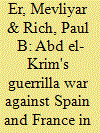

|
|
|
|
|
| Summary/Abstract |
The Riffian rebel leader Mohammed Abd el-Krim Al-Khattabi (1882–1963) became an important early guerrilla leader by successfully initiating extensively organized resistance in the Moroccan Rif against Spanish and French imperial power in the early 1920s. The Rif War triggered a wave of adventure films since the 1930s. This article will look at some of these, especially Sergeant Klems (1971) and The Wind and the Lion (1975), and suggest that they can be seen in terms of the wider impact of screen Orientalism derived from the iconic film Lawrence of Arabia (1962) directed by David Lean. The article will show that these films promoted what it terms a colonial gaze by underlining many stereotyped cinematic clichés relating to the Islamic cultural area and Abd el-Krim's revolt that stretch back to the early history of cinema.
|
|
|
|
|
|
|
|
|
|
|
|
|
|
|
|
| 2 |
ID:
112398
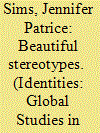

|
|
|
|
|
| Publication |
2012.
|
| Summary/Abstract |
The idea that mixed race individuals are physically attractive is a commonly accepted stereotype. Past research in which whites (Australians and British) and Asians (Japanese) were asked to rate the attractiveness of a racially heterogeneous group of faces has shown that mixed race phenotype was judged the most attractive. In this study, I examine whether there is empirical evidence for this Biracial Beauty Stereotype in the United States. Using the data from the National Longitudinal Survey of Adolescent Health, I examine self and interview ratings of respondents' physical attractiveness and, in an extension of the previous literature, conduct multinomial logistic regressions to ascertain whether level of attractiveness is associated with different racial identification choices for mixed race individuals. My results indicate that there is in fact a belief in mixed race individuals' superior beauty in America; but, with regard to identity, beauty is not associated with identity for all mixed race groups.
|
|
|
|
|
|
|
|
|
|
|
|
|
|
|
|
| 3 |
ID:
175137
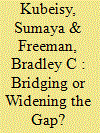

|
|
|
|
|
| Summary/Abstract |
Media researchers have often examined how film and television can have an impact on audiences. Media have various effects on audience members. When it comes to representing ‘the other’, the media often rely on stereotypes. Research has shown that ethnic Arabs are under-represented in US film and television, and their depictions are distorted with stereotypical portrayals. The current study joins the discussion on ‘media representation’ (in this case, informed by the construct of Occidentalism) by conducting a qualitative, thematic, content analysis (informed by narrative analysis, both socio-linguistic and socio-cultural) of the Jordanian television show My American Neighbor. Stereotypes can be both positive and negative, and they are often used by media storytellers regardless of their background or location in the World.
|
|
|
|
|
|
|
|
|
|
|
|
|
|
|
|
| 4 |
ID:
141467


|
|
|
|
|
| Summary/Abstract |
The proportion and visibility of Brazilian women and particularly the specific images of Brazil and Brazilians in the Portuguese imaginary have contributed to the construction of new versions of stigma and stereotypes surrounding them. Mainstream images of Brazilian women have incorporated prejudices about the sensuality of Creole women who are reminiscent of the Portuguese colonial imaginary. Starting from this stigmatised image, we show how Brazilian women entrepreneurs in the ‘beauty’ business filière reinterpret and mobilise this perceived negative image, transforming it into an added value associated with an ‘aesthetic’ Brazilian body culture. This idea of ‘body’ aesthetics becomes a business resource transformed into aesthetic–corporal capital, a key component of the Brazilian beauty business filière. Empirically, this research is based on qualitative elements, in particular 25 interviews with Brazilian women entrepreneurs of the beauty filière working in Portugal, collected for the project BELTS-W (Brazilian Entrepreneurial Links and Transnational Strategies – Women).
|
|
|
|
|
|
|
|
|
|
|
|
|
|
|
|
| 5 |
ID:
181394
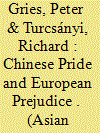

|
|
|
|
|
| Summary/Abstract |
The Chinese government’s cover-up of the origins of the new coronavirus, and its more openly prideful and aggressive foreign and human rights policies, triggered a dramatic deterioration of foreign views of China in 2020. That year also witnessed a significant increase in anti-Chinese/Asian prejudice around the world. Could the former have shaped the latter? Drawing on theories of prejudice and ideology, and using an Autumn 2020 13-nation European survey about China, this paper explores whether increasingly negative attitudes toward Chinese government policies prejudiced European views of local Chinese students, tourists, and communities. It finds substantial evidence of a spillover effect, an effect which is stronger among conservative Europeans than among progressive Europeans more motivated to avoid prejudice. The paper concludes with thoughts on the danger that China’s prideful “wolf warriors” pose for Chinese students, tourists, and local Chinese communities confronting prejudice in Europe today.
|
|
|
|
|
|
|
|
|
|
|
|
|
|
|
|
| 6 |
ID:
080442
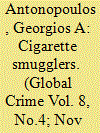

|
|
|
|
|
| Publication |
2007.
|
| Summary/Abstract |
The smuggling of contraband cigarettes is discussed in relation to numerous financial and social issues. Cigarette smugglers are often portrayed as ruthless and dangerous individuals, and according to official and media accounts a clear link has been established between cigarette smuggling and 'criminal and terrorist organisations'. The aim of this article is to challenge this stereotypical image of the cigarette smugglers based on the presentation of the stories of four smugglers interviewed in Greece and the UK
|
|
|
|
|
|
|
|
|
|
|
|
|
|
|
|
| 7 |
ID:
186310
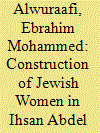

|
|
|
|
|
| Summary/Abstract |
The article examines Ihsan Abdel Quddous’s literary texts that deal with Egyptian Jewish women to explore how Egyptian Jewesses figure in these texts to disrupt, disturb, or offset prevailing historical and fictional discourses and explore his attitude toward Egyptian Jews in general and Jewish women in particular. Deploying post-colonial feminist theory, the article argues that in Quddous’ works, Jewish women represent a highly-educated and liberal community with fluid, transnational identities that serve to foil exclusionary discourses, and that Quddous increasingly has given Egyptian Jewish women, more than any other Arab writer of the period, a voice and an active role in his works. As a result, he has articulated their hopes, fears, and needs in a period dominated by political and social instability. The article aims at identifying and categorizing major tropes and characteristics pertaining to the portrayal of Jewish women in Ihsan Abdel Quddous’ fiction, and how these portrayals adhere to or play on the universal stereotypes of Jews.
|
|
|
|
|
|
|
|
|
|
|
|
|
|
|
|
| 8 |
ID:
123063
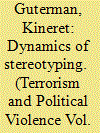

|
|
|
|
|
| Publication |
2013.
|
| Summary/Abstract |
This article considers popular ways of representing terror activists, and the metamorphoses that approaches to representation in the American media have undergone. A part of the article deals with terrorism in the media over time, common stereotypes, and how they affect the representation of Arabs and Muslims. The article then discusses Sleeper Cell (2005), a mini-series which focuses on a Jihad terror group. The article addresses questions including: How are Arabs and non-Arab Muslims portrayed in the series? Can a real change be observed over time in the method of portraying them? Twentieth-century historical considerations precede the pointed topical discussion.
|
|
|
|
|
|
|
|
|
|
|
|
|
|
|
|
| 9 |
ID:
124924
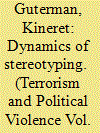

|
|
|
|
|
| Publication |
2013.
|
| Summary/Abstract |
This article considers popular ways of representing terror activists, and the metamorphoses that approaches to representation in the American media have undergone. A part of the article deals with terrorism in the media over time, common stereotypes, and how they affect the representation of Arabs and Muslims. The article then discusses Sleeper Cell (2005), a mini-series which focuses on a Jihad terror group. The article addresses questions including: How are Arabs and non-Arab Muslims portrayed in the series? Can a real change be observed over time in the method of portraying them? Twentieth-century historical considerations precede the pointed topical discussion.
|
|
|
|
|
|
|
|
|
|
|
|
|
|
|
|
| 10 |
ID:
111479
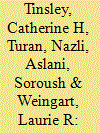

|
|
|
|
|
| Publication |
2011.
|
| Summary/Abstract |
When involved in disputes, people's stereotypes about one another and the situation can influence their attributions of motives and effectiveness at resolving the dispute. Stereotypes may be of particular concern when disputing parties have little knowledge about the individual across the table. In this study, we examined how respondents from different cultures evaluated the economic and relational goals of two disputing merchants - one from the West and the other from the Middle East. We tested the extent to which respondents' expectations of the targets' goals were driven by: 1) cultural information about each disputant (whether the merchant-disputant comes from the West or from the Middle East) and 2) the respondent's own culturally-based mental model for approaches to resolving work-related disputes. We found very little evidence of cultural stereotyping in that respondents views of the Target Merchants' goals were largely independent of the said culture of the Target Merchant. We did however find strong evidence that respondents from the United States, Turkey and Qatar hold different mental models about the goals a party has when resolving a work-related dispute. In particular, US respondents had a more variable-sum orientation than the other cultural groups, especially Qataris, whose mental model evidenced a fixed pie assumption regarding economic and relational goals. For example, Qataris and Turks viewed a goal of Maximizing one's Own Gain as impeding a goal of Maximizing the Other Party's Gain. Similarly, Qataris viewed Defending Honor as incompatible to the goals of Relationship Building and Giving Face, whereas Americans and Turks did not hold such a view. These differences, based on the country of the respondent, are discussed in detail.
|
|
|
|
|
|
|
|
|
|
|
|
|
|
|
|
| 11 |
ID:
186343
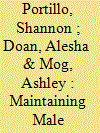

|
|
|
|
|
| Summary/Abstract |
Current debates about bathrooms and bathroom policy contribute to a long history of how space shapes norms and expectations about privacy and gender equity in the workplace. The military serves as a significant site of discussion, particularly as the Department of Defense moves forward with efforts to integrate women into combat positions. Relying on an analysis of 27 focus groups with a total of 198 participants we collected from Special Operations in the U.S. Army, we examine bathrooms as a site where male soldiers contest and resist female integration. Using Sasson-Levy and Katz’s concept of institutional de-gendering and re-gendering, we argue that men’s resistance to gender-neutral toilets is an effort to re-gender Special Forces and maintain the hegemonic masculine culture that acutely defines it.
|
|
|
|
|
|
|
|
|
|
|
|
|
|
|
|
| 12 |
ID:
157078
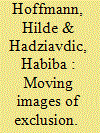

|
|
|
|
|
| Summary/Abstract |
This paper analyses the most prominent tropes in the earliest and most recent filmic representations of Roma. Stereotypical images of Roma abound in many fictional features as well as documentaries, from the representation of Roma as eternal nomads to racially prejudiced depictions of Roma women and the alleged innateness of music to Roma. Because images and modes of representation change over time, the paper juxtaposes the earliest portrayals of Roma with those produced in the last 15 years. The analysis particularly centres on two dominant reoccurring tropes: types of spaces typically occupied by Roma in film, that is the lack of a place or so-called placeless-ness of Roma; the gendered other, or the Roma woman and the culturally and ethnically othered Roma musician. Ultimately, by analysing how these tropes have persisted in varying forms over 100 years, this work points to the filmic imagery that perpetuates antiziganism, but also how the same has changed over the years to offer possible counter-narratives.
|
|
|
|
|
|
|
|
|
|
|
|
|
|
|
|
| 13 |
ID:
128880
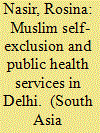

|
|
|
|
|
| Publication |
2014.
|
| Summary/Abstract |
This study is an account, largely based on field research, of how Muslims in Delhi experience the public healthcare sector. It identifies how negative memories of the Indian Emergency and sterilisation campaigns of that time may still get recalled today whenever any untoward incident happens concerning Indian Muslims in relation to public health services. The research seeks to identify to what extent this kind of historical memory translates into perceptions of disadvantage that then gradually initiate a process of self-exclusion, reinforcing a spiral of disadvantage.
|
|
|
|
|
|
|
|
|
|
|
|
|
|
|
|
| 14 |
ID:
167641
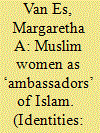

|
|
|
|
|
| Summary/Abstract |
This article explores the efforts of Dutch Muslim women who try to break the ‘oppressed Muslim woman’ stereotype by monitoring their own behaviour in everyday interactions with members of the non-Muslim ethnic majority. In representing themselves as modern and emancipated, they try to change the dominant image of Muslim women in Dutch society, and thus also that of Islam. Based on interviews and archival material, I demonstrate that initially this strategy was mostly adopted by Dutch converts to Islam, and later also by ‘born’ Muslim women. Why do more and more Muslim women turn themselves into ‘ambassadors’ of Islam? And what are the costs of this form of self-essentialization? This article demonstrates the usefulness of studying self-representations of minority groups in the light of existing stereotypes, arguing that Muslim women’s self-representations should be seen as part of a politics of belonging.
|
|
|
|
|
|
|
|
|
|
|
|
|
|
|
|
| 15 |
ID:
119063
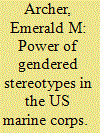

|
|
|
|
|
| Publication |
2013.
|
| Summary/Abstract |
Gendered stereotypes in the US military context often result in the creation of barriers for women. Constant confrontation with these barriers may negatively impact a servicewoman's career. The author argues that gendered stereotypes in the US Marine Corps (USMC) have the potential to undermine a female Marine's performance, and sometimes the performance of others around her. Through the application of ethnographic content analysis to thirty-five in-depth interviews (seventeen female and eighteen male Marines), this article investigates the possible consequences of gendered stereotypes in the USMC. Four themes regarding the origination, socialization, and reinforcement of gender-role stereotypes in the USMC emerge through the interview process. Findings suggest gender-role stereotypes influence (1) the perceived abilities of female Marines, (2) the initial socialization of Marines, (3) camaraderie and opportunities for female Marine mentorship, and (4) a culture of double standards. The aforementioned themes are compared to findings in the literature and implications for camaraderie, shared sense of mission, and leadership are discussed.
|
|
|
|
|
|
|
|
|
|
|
|
|
|
|
|
| 16 |
ID:
080670
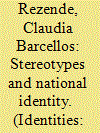

|
|
|
|
|
| Publication |
2008.
|
| Summary/Abstract |
In this article, I examine how stereotypes are deployed in the process of experiencing national identities. Specifically, I analyse how a group of Brazilian academics who have studied in Europe and the United States have dealt with stereotypical notions of Brazilians as "warm people" who establish friendship "easily." Ideas about a "greater emotionality," which were often seen as negative from a European colonial perspective, are embraced and re-signified by them as a positive feature of Brazilian national identity, particularly when compared to the supposed "closed nature" of some Europeans. I argue therefore that the presence of such stereotypes contributes to reinforce a subjective sense of Brazilianess and also reveals the negotiations of power relations in the process of elaborating Brazilian national identity
|
|
|
|
|
|
|
|
|
|
|
|
|
|
|
|
| 17 |
ID:
178956
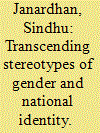

|
|
|
| 18 |
ID:
190785
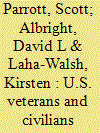

|
|
|
|
|
| Summary/Abstract |
The news media often portray military veterans in stereotypical ways, providing audiences narrow representations in which veterans are traumatized heroes. What happens when a veteran sees these storylines and assumes they affect how the public thinks about veterans? This question informs this study, which used a two-prong approach (online, telephone) to survey 1,047 American adults about news media and veterans. Respondents, including veterans and civilians, were asked to recall news stories about veterans, assess the quality of news coverage of veterans, and offer opinions concerning whether news coverage affects themselves and other people. When respondents could recall a news story about veterans, they described stereotypical stories related to victimization/harm, heroism, charity/social support, mental illness, and violence. Respondents, both civilian and veteran, described news coverage as mediocre and felt the news affects other people more than themselves.
|
|
|
|
|
|
|
|
|
|
|
|
|
|
|
|
| 19 |
ID:
100757
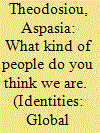

|
|
|
|
|
| Publication |
2010.
|
| Summary/Abstract |
In Parakalamos (a village in NW Greece) Gypsyness, historically constituted as a "disheveled otherness," claims a space of encounter with people and actions that are "other," but also arise from within, ossified, but also ephemeral and fleeting. By exploring the way Gypsies in Parakalamos discussed and experienced processes of identification, I shift the issue of Gypsy otherness away from the well-ordered schema of neatly divided communities usually found within Gypsy ethnography, and I am concerned with the scenography of Gypsy difference: drawing upon a more general discussion on stereotypes, identity, and difference, I explore the situatedness, instability and partial character of Gypsy performances of difference, which nonetheless cannot lie outside the topography of marginality in and through which Parakalamos Gypsies have emerged as particular historical subjects.
|
|
|
|
|
|
|
|
|
|
|
|
|
|
|
|
| 20 |
ID:
154061
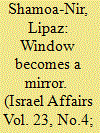

|
|
|
|
|
| Summary/Abstract |
This paper examines attitudes and stereotypes in intergroup dialogue (religious, secular) via the Johari Window model. Participants (N = 114) presented perceptions of the in-group and a data analysis revealed three prominent findings: (1) the presence of out-group members in the measuring of attitudes contributed to the moderation of stereotypes towards the in-group; (2) the measure of attitudes in the group setting and in conditions of numerical equality among groups intensified discrimination in favour of the in-group within the minority group; (3) presentation of attitudes on the in-group while being aware of the out-group members contributed to the process of defining identities. The theoretical contribution of this paper lies in the understanding of the role of perceiving an identity, in the process of formation of stereotypes in the intergroup dialogue. From a practical viewpoint, a helpful tool is presented for the improvement of communication patterns in general and in dialogues among groups who are in conflict in particular.
|
|
|
|
|
|
|
|
|
|
|
|
|
|
|
|
|
|
|
|
|